Forty-seven observations in the irrational connections between human and nature.
The post ‘Symphony No. 42’ by Réka Bucsi appeared first on Cartoon Brew.
Add a Comment
Forty-seven observations in the irrational connections between human and nature.
The post ‘Symphony No. 42’ by Réka Bucsi appeared first on Cartoon Brew.
Add a Comment
Since I began championing children’s book on this website I’ve had a lovely game I indulgently play in my head: Who would I interview if I could interview anyone?
Over the years one name repeatedly popped up, but I didn’t dare act on my daydreams until very recently. It all started earlier this year when Dick King Smith’s The Rats of Meadowsweet Farm arrived on my desk. Published in a fantastic new edition by Barrington Stoke as part of their covetable Little Gems series, it featured illustrations by none other than the subject of my aforementioned daydreams: Victor Ambrus. Victor turned 80 this year, and I hadn’t realised that he was still working and so the flame on my candle of hope burned a little brighter, but my bravery still stumbled.

Then last month another Barrington Stoke book made its way into my hands. The Seal’s Fate by Eoin Colfer is also illustrated by Victor Ambrus, and I was so moved by the visual and verbal storytelling, it gave me the courage I needed. It’s a powerful book I’d really like to tell everyone about and it provided me with the final spur on to make an interview request.

Victor Ambrus has won the Kate Greenaway medal twice (for ‘The Three Poor Tailors’ [1965] and ‘Horses in Battle'[1975]) and has illustrated more than 300 books. His historical illustrations showing archaeological interpretations were featured on Channel 4’s Time Team for 20 years. Indeed, his passion for illustrating history has been central to his career, both in children’s book illustration and also in adult non-fiction. Ambrus’ animal illustrations are also especially highly regarded and have formed another constant strand in his work, from his illustrations for K.M. Peyton’s Flambards series right up to his two newest books with the grimy humour of the rats and the soft, sweet eyes of the seal.
And thus the time came for me to interview Victor over the phone. Victor was born in Hungary in 1935 and I started by asking what sort of reading life he had had as a child, what books he had loved. I was all ready to look up lots of Hungarian authors (and quite keen to do so, as I studied Hungarian literature at University) but “no, there were numerous books, but they were all English books – in translation of course. I was bought up on things like Winnie the Pooh!” Many were given to him as presents and one of his favourite books was Ursula Moray Williams’ ‘Adventures of the Little Wooden Horse’. It was, however, the books of Arthur Rackham that in many ways changed his life forever. “He was a huge influence on me… and he meant that I’ve been drawing ever since I could hold a pencil!”

Victor’s immediately family weren’t especially artistic (though he grew up with tales of a particularly talented uncle who had died young during the influenza epidemic following the First World War), but they were immensely supportive of Victor’s growing interest in drawing. Victor’s father, an industrial chemist, was especially encouraging: “He was convinced I was going to be an artist when I grew up.”
Victor’s passion for historical illustration was laid down as a child: “I just drew and drew and drew and enjoyed it. I illustrated anything that I read – books on history, poems… in fact I did a vast number of drawings of the fights we Hungarians had with the Turks in the 17th century.”
“But then there came a point where I had to enter grammar school. But I still kept drawing and drawing and eventually I got to a point where I could apply for the Academy of Fine Art, a very fine, traditional school offering a classical training in drawing, including anatomy and all sorts of things you don’t often get these days. But illustration per se didn’t come into my training actually. It was all terribly straight-laced. Illustration was just something I did for myself.”
Victor’s education and training at the Academy of Fine Art was cut short in awful circumstances. In 1956 the Soviet Union invaded Hungary and life in Budapest became very hard. There came a point where Victor had to make what he himself describes as “a kind of life or death decision”; to leave Hungary and seek refuge abroad.
“It was very demanding physical conditions. There was heavy snow you had to walk through all night to get across the border. It was a kind of life or death decision. I had to leave family behind. I actually had no choice. They had a list of people who were attempting to hold the Academy building against the Russian tanks. I was one of these people… but I did a very bad job at it. It was terribly frightening. Eventually they cornered us in the basement of the building and they executed eight of us on the spot – four students and four regular [Hungarian] army soldiers. I was lucky to survive it.”
Victor eventually made his way to the Austrian border and from there he chose to make England his new home, with the much-loved books and illustrations from his childhood very much in mind. He ended up in Farnham and from there applied to the Royal College of Art. Education there was quite different to that Victor had experienced in Budapest’s Academy of Fine Art: “The Royal College was very much more liberal. It was a kind of a loosening up process.”
Victor’s early work included a lot of lithographs and etchings. “Etchings have played a big influence in my life because they produce fine quality lines and nice deep tones which appeal to me, even though I haven’t made any for quite some time because of you need quite sophisticated machinery, making it hard to do at home. Still, I was almost addicted to using very fine lines and my early illustrations are very like etchings except that they were not actually printed etched into glass plates – rather, I just used a very fine nib.”
I’m very curious about this passion for etching and how that tallies with Victor’s style now which to me seems much more fluid, looser and more vibrant than is typically achieved with the precise lines in etching. Was this something Victor himself recognised? “Yes, I turned away from this approach, probably because of the subjects I was getting – I was getting a lot of free flowing, fast action historical illustrations, where people might be riding a horse or fighting, and to start using very fine etching lines was not practical. It took a long time and gave the wrong effect. It became very laboured.”
“And then at this time when I was getting going, colour illustration came in in a big way and so I got into colour and my approach changed somewhat. I’d draw things up very quickly in pencil making sure everything moved the way I wanted it to and then I’d apply colour and more sweeping lines. But thinking about colour… funnily enough I think black is a very important thing in my drawings. I like to have the impact of black in an illustration – once I have heavy black lines I can use more intense colours. In a way the black boosts the colours I use, it makes the colour really work.”
Victor uses ink and also water soluble pencils for his black lines and part of the secret to the way he uses them is that “the most intensive black goes down when the illustration is done – then I can see exactly where it is needed, where it needs a punch.”

But taking a step back, to explore a little further this change in approach, this development in Victor’s illustrative style. It was whilst at the Royal College that Victor had a stroke of luck which led to his breakthrough as a book illustrator. He was commissioned by Blackie and Sons to illustrate a book with a lot of horses – a love of Victor’s since his youth spent working on the great Hungarian plains where he would often witness large groups of semi-wild horses in their natural habitat. That books was White Horses and Black Bulls by Alan C Jenkins and on the back of a review in the Times Literary Supplement which included two of Victor’s illustrations (“It caused quite a stir!”) suddenly a stream of horse-related illustration commissions started flowing Victor’s way.
“Luckily I love drawing horses… why? because they are so complicated… so impressive!”
At that point, Victor couldn’t himself ride but as he received more and more historical illustration commissions he realised this would have to change if he wanted his pictures to be authentic; it was very important to him to accurately capture how people sit when they are riding.
This commitment to detail, this concern for accuracy is another mainstay in all of Victor’s work: “I really enjoy the research. It’s important as otherwise the illustrations don’t feel convincing. It’s got to be right!”
On occasion, however, this drive for authenticity has led him into a spot of bother: “Well I didn’t know how they used a sword on horseback. Now I happened to have a sword and so I took it out and practised with it. I rode in the local forest where there were a lot of pine trees and I would take aim at a branch, swipe at it and see what was the best way of cutting it. Oh I enjoyed it! But then I had to stop because one day a swipe revealed a white-faced mushroom picker who was scared out of his skin. I hadn’t realised he was there and at that point I thought I’d better not do this any more and so I put the sword away.”
Another area of great interest for Victor when it comes to illustration, especially historical illustration, is costume and clothing. Whilst he studied at the Royal College he spent many hours just down the road in the Victoria and Albert Museum. “I’d sooner illustrate any period but the modern because the clothes are boring – there’s no colour – whereas the 17th, 18th century… ah, they are fabulous!” I’m very sorry when later in our conversation I find out that Victor’s own wardrobe at home isn’t full of the colourful and rich outfits he loves to draw.

An interior illustration from The Seal’s Fate
As well as historical illustrations, Victor has always enjoyed drawing animals. And not just horses. “I’ve spent a lot of time in zoos. One of my favourite drawings I did in London Zoo, of a fantastic male gorilla. He sat there and stared at me for a long time and when I finished the drawing and walked away he came up to the fence, right up to the edge. And other people nearby said, ‘Show him, show him your picture of him,’ and so I turned around and showed the picture to him and it was quite amazing. He took it all in, with his eyes wide open. I don’t know what he thought of it but he was definitely puzzled.”
Animals have not always been so appreciative of being drawn by Victor though. “Once I was drawing a lovely big parrot who was on the end of a long post, at the far end, and I was drawing him and enjoying myself until he started to move up the post step by step. He came right up close to me and then it was absolutely amazing – he looked at me and reached forward and took the pencil from my hand, snapped it into two and chucked it behind him and walked off! I thought it was a devastating piece of criticism of my efforts! I was utterly speechless!”
Being observed whilst drawing is something which has played an important role throughout Victor’s career. For many people, he will be most famous as the illustrator for Channel 4’s Time Team (one of my own favourite programmes as a child), where archaeologists had three days to excavate a site, and Victor would draw interpretations of the site and archaeological finds, being watched whilst he did so not only by members of the public visiting the excavations but also by millions on TV.
And it’s actually all thanks to The Reader’s Digest that Victor became part of the brilliant Time Team crew. One day in a Bristol library, the director of Time Team came across Victor’s illustrations in a history of Britain published by The Reader’s Digest. A phone call later and the two of them met. “‘Can you draw quickly?’ ‘Ah.. yes, I can try’ ‘Well, draw a portrait of me then,’ and so I drew a quick-as-lightning pencil drawing of him and he was suitably impressed and the following week I was invited to go to Oxfordshire…” and the rest, as they say, is history, with the programme running for 20 years.
“It was a wonderful opportunity to see places you’d never get to … all sorts of weird places and drawing all different things. Of course it was sometimes a bit of an ordeal because your hands get so cold drawing outside, but the hand-drawn illustrations brought something special – by being hand-drawn, the image is more alive, it is saying this how it could have been, whereas a computer printout will say this is how it was and there is no argument.”
Did Victor ever get to have a go at digging? “It appealed to me – oh yes – but they never let me near the ground. I used to try to persuade Phil Harding [one of the Time Team Archaeologists] to let me have a dig but he would snarl at me and tell me to keep my hands out of the ground and keep on with my drawing!”

A sample of Victor Ambrus’s illustrations at Athlone Castle. Copyright: Emilia Krysztofiak Rua Photography 2012
And keeping on with his drawing is what Victor has been doing and continues to do, even as he enters his ninth decade. Recent commissions include creating illustrations for the museum at Athlone Castle in the Republic of Ireland, an opportunity to return to his beloved 17th century, horses and interesting clothes, but also a chance to steep himself in the landscape and people of Ireland – a boon when it came to illustrating his most recently published book for children, The Seal’s Fate. And right now he is steeped in the history of Somerset whilst he finishes off a big project for the Taunton Castle Museum, covering Somerset from its prehistory “up to Butlins!”
But being busy drawing makes Victor happy. “I couldn’t imagine it otherwise. I’d miss it if I wasn’t drawing. I’m just obsessed with drawing. Even when I’m not drawing I might be thinking about drawing.” And with 300 books and a lifetime of illustrating under his belt, what advice would he have for children who were interested in illustrating?
“Draw and draw and draw. And it’s important not just to do the drawing you have to do, but to draw for yourself, just to please yourself.”
 I’m indebted to Victor for being so generous with his time and stories from his life. When I asked him to check over my interview notes and make any changes he wished to see, the only thing he wanted to add was that he has “a lovely wife and two big sons.” This, to me, speaks volumes of Victor’s understated modesty, charm and warmth which I hope has come across in this dream-come-true disguised as an interview.
I’m indebted to Victor for being so generous with his time and stories from his life. When I asked him to check over my interview notes and make any changes he wished to see, the only thing he wanted to add was that he has “a lovely wife and two big sons.” This, to me, speaks volumes of Victor’s understated modesty, charm and warmth which I hope has come across in this dream-come-true disguised as an interview.
Living a comfortable life in Tel Aviv, Nessya, 12, is stunned to hear that her grandmother, Miri Malz, has been invited to speak at her school's Holocaust Remembrance Day program. Nessya has never heard her happy, smiling grandmother speak being a Holocaust survivor, and besides, she doesn't even have at tattoo AND she has her family's old photo albums - items always destroyed by the Nazis.
 |
| Miri and her older sister Magda |
Fin de siècle Hungary was a progressive country. It had limited sovereignty as part of the Austro-Hungarian dual monarchy, but industry, trade, education, and social legislation were rapidly catching up with the Western World. The emancipation of Jews freed tremendous energies and opened the way for ambitious young people to the professions in law, health care, science, and engineering (though not politics, the military, and the judiciary). Excellent secular high schools appeared challenging the already established excellent denominational high schools.
The post Beyond Budapest: how science built bridges appeared first on OUPblog.
Enter to win a full autographed set of the If You Were Me series, by award-winning author Carole P. Roman; including the newest addition If You Were Me and Lived in … Hungary: A Child’s Introduction to Cultures Around the World! Giveaway begins January 24, 2015, at 12:01 A.M. PST and ends February 23, 2015, at 11:59 P.M. PST.
Add a CommentCarol P. Roman’s If You Were Me and Lived in … Hungary: A Child’s Introduction to Cultures Around the World is the thirteenth in her series briefly introducing young readers to our world’s diverse cultures.
Add a CommentBased on a silly Hungarian children's poem by János Lackfi, preformed by Pista Busa a superb Hungarian rapper/beatboxer.
Add a CommentAnimated Fragments is our semi-regular feature of animation tests, experiments, micro-shorts, and other bits of cartoon flotsam that don't fit into other categories.
Add a Comment
July 1914 was the month that changed the world. On 28 June 1914, Archduke Franz Ferdinand was assassinated, and just five weeks later the Great Powers of Europe were at war. But how did it all happen? Historian Gordon Martel, author of The Month That Changed The World: July 1914, is blogging regularly for us over the next few weeks, giving us a week-by-week and day-by-day account of the events that led up to the First World War.
By mid-day Friday heads of state, heads of government, foreign ministers, and ambassadors learned the terms of the Austrian ultimatum. A preamble to the demands asserted that a ‘subversive movement’ to ‘disjoin’ parts of Austria-Hungary had grown ‘under the eyes’ of the Serbian government. This had led to terrorism, murder, and attempted murder. Austria’s investigation of the assassination of the archduke revealed that Serbian military officers and government officials were implicated in the crime.
A list of ten demands followed, the most important of which were: Serbia was to suppress all forms of propaganda aimed at Austria-Hungary; the Narodna odbrana was to be dissolved, along with all other subversive societies; officers and officials who had participated in propaganda were to be dismissed; Austrian officials were to participate in suppressing the subversive movements in Serbia and in a judicial inquiry into the assassination.
When Sazonov saw the terms he concluded that Austria wanted war: ‘You are setting fire to Europe!’ If Serbia were to comply with the demands it would mean the end of its sovereignty. ‘What you want is war, and you have burnt your bridges behind you’. He advised the tsar that Serbia could not possibly comply, that Austria knew this and would not have presented the ultimatum without the promise of Germany’s support. He told the British and French ambassadors that war was imminent unless they acted together.

Sergey Sazonov, public domain via Wikimedia Commons
But would they? With the French president and premier now at sea in the Baltic, and with wireless telegraphy problematic, foreign policy was in the hands of Bienvenu-Martin, the inexperienced minister of justice. He believed that Austria was within its rights to demand the punishment of those implicated in the crime and he shared Germany’s wish to localize the dispute. Serbia could not be expected to agree to demands that impinged upon its sovereignty, but perhaps it could agree to punish those involved in the assassination and to suppress propaganda aimed at Austria-Hungary.
Sir Edward Grey was shocked by the extent of the demands. He had never before seen ‘one State address to another independent State a document of so formidable a character.’ The demand that Austria-Hungary be given the right to appoint officials who would have authority within the frontiers of Serbia could not be consistent with Serbia’s sovereignty. But the British government had no interest in the merits of the dispute between Austria and Serbia; its only concern was the peace of Europe. He proposed that the four ‘disinterested powers’ (Britain, Germany, France and Italy) act together at Vienna and St Petersburg to resolve the dispute. After Grey briefed the cabinet that afternoon, the prime minister concluded that although a ‘real Armaggedon’ was within sight, ‘there seems…no reason why we should be more than spectators’.
Nothing that the Austrians or the Germans heard in London or Paris on Friday caused them to reconsider their course. In fact, their general impression was that the Entente Powers wished to localize the dispute. Even from St Petersburg the German ambassador reported that Sazonov’s reference to Austria’s ‘devouring’ of Serbia meant that Russia would take up arms only if Austria seized Serbian territory and that his wish to ‘Europeanize’ the dispute indicated that Russia’s ‘immediate intervention’ need not be anticipated.
Berchtold made his position clear in Vienna that afternoon: ‘the very existence of Austria-Hungary as a Great Power’ was at stake; Austria-Hungary must give proof of its stature as a Great Power ‘by an outright coup de force’. When the Russian chargé d’affaires asked him how Austria would respond if the time limit were to expire without a satisfactory answer from Serbia, Berchtold replied that the Austrian minister and his staff had been instructed in such circumstances to leave Belgrade and return to Austria. Prince Kudashev, after reflecting on this, exclaimed ‘Alors c’est la guerre!’
Gordon Martel is a leading authority on war, empire, and diplomacy in the modern age. His numerous publications include studies of the origins of the first and second world wars, modern imperialism, and the nature of diplomacy. A founding editor of The International History Review, he has taught at a number of Canadian universities, and has been a visiting professor or fellow in England, Ireland and Australia. Editor-in-chief of the five-volume Encyclopedia of War, he is also joint editor of the longstanding Seminar Studies in History series. His new book is The Month That Changed The World: July 1914.
Subscribe to the OUPblog via email or RSS.
Subscribe to only history articles on the OUPblog via email or RSS.
The post The month that changed the world: Friday, 24 July 1914 appeared first on OUPblog.
Maggie Steele, the storybook heroine who vaults over the moon, has been attracting thousands of visitors from around the world. So many visitors, in fact, that she’s using a time zone map to keep track of them all.* People are … Continue reading ![]()

Foam Bath (Habfürdő, 1979) is a film that I’d seen only in bits and pieces so it was exciting to stumble onto the full version posted online. It’s not the best print, and it’s in Hungarian, but its uninhibited creativity shines through. According to animation historian Giannalberto Bendazzi, the 1979 musical directed by György Kovásznai depicts “a groom-to-be who would like to cancel his weding, the bride’s best friend who is falling in love with the groom, the wedding and, overall, the disillusionment of a generation.” Hungarian Brew readers, please feel free to add to this synopsis. This is the entire film:
A painter and fine artist, Kovásznai utilizes collage techniques and optical effects to create a dense world of visual delights. But more than just an eclectic mix of graphic techniques, he succeeds at creating a universe in which the movement and acting is purely graphic. The thoughts and feelings of his character are expressed through stylized actions that reject the conventional principles of character animation. His characters transform and fragment into different shapes, fracture into pieces, shrink, expand, and change designs shot by shot, all without any loss of comprehension by the audience. An example can be seen in this spectacular four-second shot:
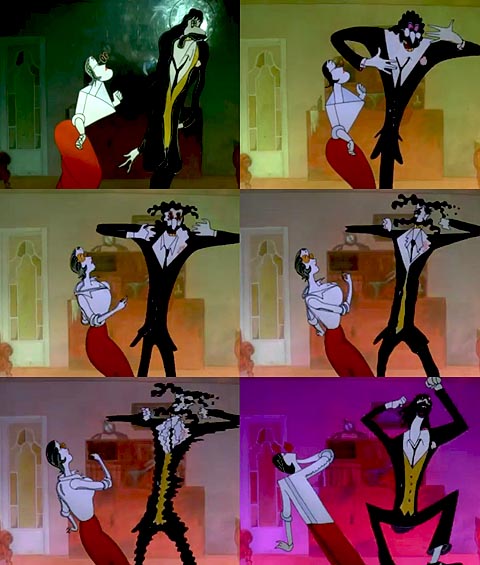
Kovásznai understands the power of the drawing to express a range of emotions and feelings that can’t be captured by a live-action camera. The film suggests a new range of symbolic acting possibilities in character animation, while showing that the animated character is far more malleable than most Western filmmakers dare to consider (although Japanese animators have certainly continued to explore in Kovásznai’s direction). Sadly, we don’t know how much further Kovásznai could have pushed the visual language of animation. Shortly after completing the film, he was diagnosed with leukemia. He died in 1983 at the age of 49.




One of the most unique voices in animation, Marcell Jankovics, the Hungarian director of features like Fehérlófia and shorts like Sisyphus, has completed a new feature. And this is not any film, but a two-hour, forty-minute epic that was in production for nearly 25 years!
The film, Az ember tragédiája (The Tragedy of Man) was released in Hungary last December. It’s adapted from a famous Hungarian play of the same name written by Imre Madách. A film review by Vassilis Kroustallis suggests that it’s relentlessly bleak and somewhat repetitive, yet worth seeing:
Lucifer, the co-creator of the world (according to his statement) tests Adam and puts him to sleep to see his destiny through the ages. The trip is interesting, visually stimulating (but never pretty), and relentlessly repeating. Not a single note of happiness or laughter enters The Tragedy of Man, which proceeds from the Garden of Eden to Egypt and then to classical Greece, Rome, Christianity and beyond…The choice of the stories to tell is varied and remarkable. Along with the usual historical suspects (Danton and the French Revolution, Hitler and Stalin), the Miltiades story from Greece (a general who becomes a traitor), and the Tancred and Crusades segment—along with the battles on the Filioque—are a treat to watch in this context.
Jankovics’ work is always a unique visual experience, and one expects this to be no different. Aeon Flux creator Peter Chung described Jankovics’ style best when he wrote that Jankovics can “make the movement a primary aspect of the design. Every element—character & setting, foreground & background, color & shape, is integrated into a total composition in motion. It approaches the idea of animation as a visual equivalent to music, with analogs to melody, rhythm and harmony working in a non-literal evocation of ideas and feelings.”
Below are a few stills from The Tragedy of Man:
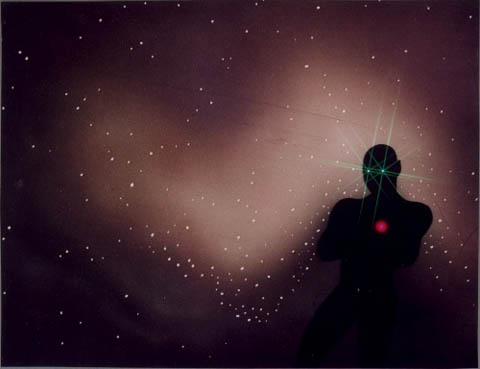
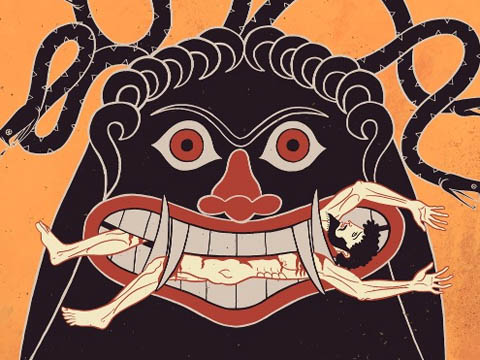
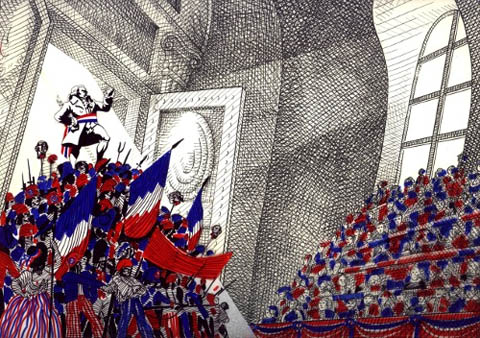
Cartoon Brew | Permalink | One comment | Post tags: Az ember tragédiája,
Add a Comment
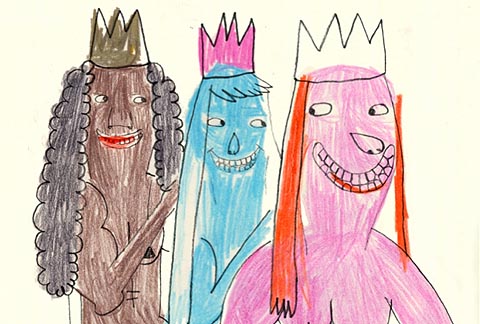
Anybody can draw in a naïve art style, but few do it well. Muscular Princesses (original title: Izmos királylányok) by Júlia Farkas uses a deceptively childlike style to illustrate a decidely “fractured” fairy tale. There is expressive character animation, creative staging choices, and a playful sense of visual humor that matches the absurd tone of the story. The results brought a smile to my face. It’s a 2009 graduation film from the Moholy-Nagy University of Art and Design in Budapest.
Cartoon Brew: Leading the Animation Conversation |
Permalink |
No comment |
Post tags: Hungary, Julia Farkas
Read THIS if you want to know more about Animated Fragments. Subscribe to our channel on Vimeo to see all the Fragments.
Supreme Believers (Nowness edit) by Universal Everything (UK)
Fancy One by Anthony VanArsdale (USA)
Tram (excerpt) by Rozi Békés (Hungary)
Gahhd Beckay, first dialogue animation by Karl Hadrika (US)
Vintage animation test by Ollie Johnston, one of Disney’s Nine Old Men (US)
Cartoon Brew: Leading the Animation Conversation |
Permalink |
No comment |
Post tags: Anthony VanArsdale, Hungary, Karl Hadrika, Ollie Johnston, Rozi Békés, UK, Universal Everything
 I fell off the radar temporarily last week. Lost all communication. It was a combination of the end of school, huge trip, and finishing my WIP, Pelorus Jack.
I fell off the radar temporarily last week. Lost all communication. It was a combination of the end of school, huge trip, and finishing my WIP, Pelorus Jack.
Most of all, though, I was an emotional wreck. My kids left on Friday with my husband for Germany. I stayed at home in the empty nest.
My husband grew up and lived most of his live in Germany until I "imported" him to the U.S. after we got married. Since the girls are a blend of two cultures, we try really hard to get them over to Germany once a year to visit family and friends. This year, we decided they were old enough for a deeper "cultural immersion" program. We're sending them to school there. Which means, I won't see them for 2 and 1/2 weeks. A lifetime.
I was scared and nervous. They were scared and nervous. I'm pretty sure I sprouted countless new gray hairs within those last hours leading up to their flight. The closer it got, the more I asked myself, Why am I doing this? Is it that important for them to be able to speak and understand German?
After I had a good cry, a glass of wine, and a serious portion of Jane Austen, I came to the same conclusion I'd been coming to all year. Sometimes doing what is best in the long run means surmounting some steep short run costs.
My motivation is all experiential. My family is a big, Hungarian family. My generation, however, is the first that didn't learn to speak Hungarian. My grandfather (1st generation American) speaks, writes and reads it. My father (2nd generation) learned only to speak it, and gradually lost it when he grew up. I (3rd generation) only learned to curse in it. Not very useful when trying to communicate in Budapest at age 19, let me tell you.
More than that, though, my whole life I've always felt like there was this big part of my family, my culture, my own history that was lost to me. Moving to America was definitely a step up for us, but we left behind family and traditions in Hungary. Ones I will never really get to know because linguistically, I've lost the tying thread.
I don't want my kids to feel like that. I want them to feel a part of both of their cultures. I also feel like tolerance grows from a more organic and personal relationship to various cultures. One begins to see that things can be done differently and it's still great. Diversity is the spice of life.
So, they start school on Thursday in Germany. Our friends with whom the girls are staying have two boys the same age. They live in a small town. My kids will be the star guests at their school. I'm so excited for them. It's going to be the experience of a lifetime.
If only I could miss them a little less....
Hotel Aranyhomok - Kecskemet, Hungary
Beautiful luggage label for Hotel Aranyhomok. The hotel still exists.
image via itton.hu
No Tags
Grand Prize goes to MidcenturyMaude 2nd Prize goes to Abby S
©2009 Grain Edit
Oh my goodness, Victor Ambrus! He is one of my favorites, too, although I only know his work from illustrations in middle grade novels–there is so much more to discover! We even had lunch in Athlone this summer; I wish I had known about the exhibition. Thank you for this wonderful interview.
Thank you Anamaria, it was such an honour to speak at length with him. Would you say he is quite well known in the US?
A wonderful interview with a hero of mine! I absolutely loved the Hester Burton novels that Victor Ambrus illustrated, and my heart did a happy flip when I saw that familiar style on the new Barrington Stoke book. Thank you, Zoe and Victor.
Delighted you enjoyed the interview so much Pippa. It was such a pleasure to interview Victor.